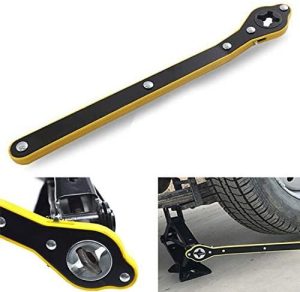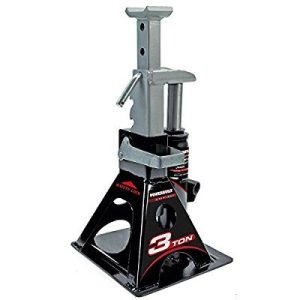Lifting your car can be a daunting task, especially if you’re unfamiliar with the process. But with the right knowledge and tools, changing a flat tire or performing basic maintenance becomes a breeze. A crucial aspect of safe car jacking lies in using the designated jack points. These reinforced areas on your car’s frame are designed to handle the weight of the vehicle when lifted. Using the wrong spot can damage your car and lead to dangerous situations.
This guide will shed light on where to put your car jack, ensuring a safe and smooth experience.
Understanding Car Jack Points
Car manufacturers design their vehicles with specific points designated to bear the weight of the car during jacking. These jack points are typically made of high-strength steel and can be easily identified by their reinforced structure.

Here are some common locations for car jack points:
- Pinch welds: These are the raised sections along the car’s rocker panel, located just behind the front wheels and in front of the rear wheels. They often have notches or markings to indicate the jack placement area.
- Frame rails: The car’s frame rails are strong beams that run along the length of the underside. Some vehicles have designated jack points on these rails.
- Subframe sections: Certain vehicles have jack points on specific subframe sections, such as the front subframe or the rear differential housing.
Consulting your car’s owner’s manual is the absolute best way to pinpoint the exact location of your jack points. The manual will provide clear diagrams and instructions specific to your car model.
Dangers of Using the Wrong Jack Point
Improper jack placement can lead to a multitude of problems, including:

- Vehicle damage: Jacking on a non-reinforced area can bend or crush the car’s frame, rocker panel, or other components.
- Vehicle instability: Using the wrong jack point can cause the car to become unbalanced and potentially slip off the jack, leading to serious injury.
- Jack failure: A jack placed on an uneven or weak area can overload the jack itself, causing it to fail and potentially dropping the car.
By following the manufacturer’s recommendations and using the designated jack points, you can avoid these dangers and ensure a safe and successful car jacking experience.
Finding Your Car’s Jack Points Without a Manual
If you can’t locate your owner’s manual, there are a few alternative ways to find your car’s jack points:
- Online resources: Many car manufacturers offer downloadable owner’s manuals on their websites. You can search for your specific car model and year to find the manual.
- Car forums and communities: Online car forums and communities can be a wealth of information. Search for your car model and see if other users have posted information about jack point locations.
- Consult a mechanic: A qualified mechanic can help you locate the jack points on your car.
Remember, it’s always better to be safe than sorry. If you’re unsure about where to place the jack, err on the side of caution and consult a professional.
Additional Tips for Safe Car Jacking
Once you’ve identified your car’s jack points, here are some additional tips for safe car jacking:

- Use a jack with the appropriate weight capacity: Make sure your car jack is rated for the weight of your vehicle.
- Park on a level and solid surface: Avoid jacking your car on an uneven surface or soft ground like dirt or sand.
- Engage the parking brake and chock the wheels: This will prevent the car from rolling while you’re jacking it up.
- Lower the car slowly and carefully: Once you’re done with your work, lower the car slowly and controlled using the jack.
- Never get under a car supported only by a jack: Always use jack stands to support the car’s weight while you’re working underneath it.
By following these tips and using the designated jack points, you can safely lift your car and perform essential maintenance tasks.
When to Consider Professional Help
While jacking up your car can be a relatively simple task, there are situations where it’s best to call in a professional. Here are a few instances:

- If you’re unsure about where the jack points are located.
- If you don’t have the proper tools or equipment.
- If you’re uncomfortable working on your car.
- If your car is severely damaged or inoperable.
A qualified mechanic will have the experience and expertise to safely jack up your car and perform the necessary repairs.
Essential Tools and Equipment for Safe Car Jacking
Now that you understand the importance of using the designated jack points, let’s explore the essential tools and equipment you’ll need for safe car jacking:
- Car jack: This is the device that will lift your car. There are various jack types, but the most common for home use are scissor jacks and hydraulic jacks. Ensure your jack has a weight capacity that exceeds your car’s weight.
- Jack stands: These are sturdy stands that provide stable support for your car once it’s lifted by the jack. Never work underneath a car supported only by a jack; always use jack stands.
- Wheel chocks: These wedges are placed behind the wheels that remain on the ground to prevent the car from rolling.
- Lug wrench: This wrench is used to loosen and tighten the lug nuts that secure your wheels.
- Gloves: Wearing gloves will protect your hands from dirt, grease, and potential scrapes during the jacking process.
- Flashlight: Having a flashlight handy is crucial, especially if you’re working in low-light conditions.
Optional but helpful tools:
- Socket wrench set: A socket wrench set with various socket sizes can be helpful for removing lug nuts and other fasteners.
- Torque wrench: A torque wrench ensures the lug nuts are tightened to the manufacturer’s recommended specifications.
- Creeper: A mechanic’s creeper allows you to comfortably lie on the ground while working underneath the car.
By having the right tools on hand, you can ensure a smooth and efficient car jacking experience.
Performing Basic Maintenance Tasks with Confidence
With your car safely jacked up and secured on jack stands, you can now perform various maintenance tasks, such as:

- Changing a flat tire: This is a common reason why people need to jack up their car. Once the car is lifted, you can easily remove the flat tire and replace it with your spare.
- Rotating tires: Regularly rotating your tires helps to extend their lifespan and improve handling. Jacking up each corner of the car allows you to move the tires to their designated positions.
- Checking the brakes: You can inspect your car’s brake pads and rotors for wear and tear by jacking up the car and removing the wheels.
- Changing the oil: While an oil change can often be done without jacking up the car, it can provide easier access to the oil drain plug and filter in some vehicles.
By knowing where to put your car jack and using the proper techniques, you can tackle these basic maintenance tasks with confidence and save yourself money on mechanic visits.
Empower Yourself with Knowledge
Equipping yourself with the knowledge of safe car jacking empowers you to handle unexpected situations like flat tires or perform basic maintenance tasks at your convenience.
Invest in a quality car jack and jack stands, and keep them readily accessible in your trunk. Familiarize yourself with your car’s owner’s manual and locate the designated jack points.
Remember, safety is paramount. If you’re unsure about any step of the process, don’t hesitate to consult a qualified mechanic. With a little knowledge and the right tools, you can conquer car jacking and keep your vehicle running smoothly.





